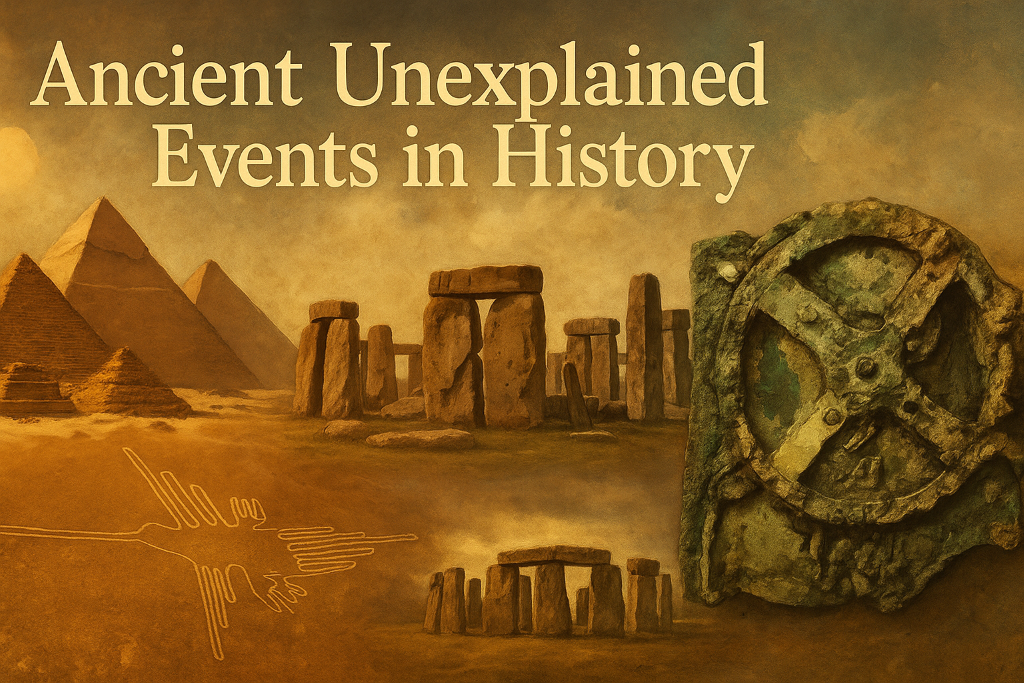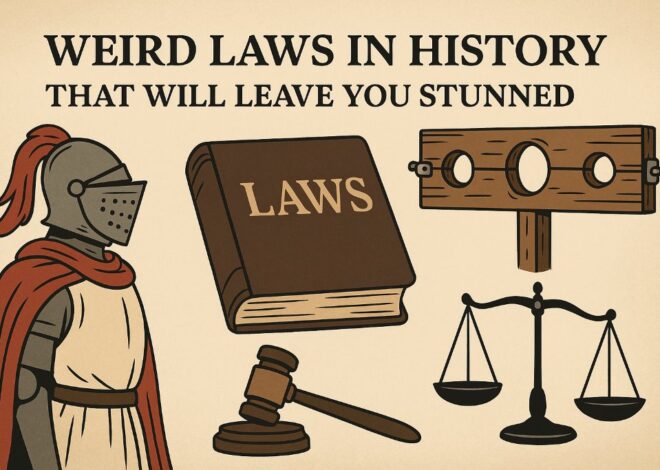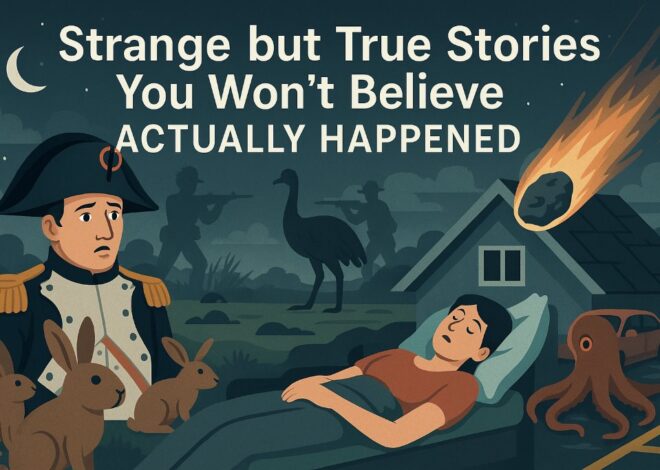
The Most Unexplained Events in History
Some things in the past simply refuse to make sense, no matter how many books are written or how many experts weigh in. These unexplained events in history don’t sit quietly in a museum case—they keep whispering from the shadows, reminding us how little we really know. From ancient stone circles to modern radio signals, every era has left behind strange but true stories that don’t quite add up And the strangest part is, the more we study them, the more tangled they seem. That’s why people still chase after these unexplained events in history, half hoping for answers, half terrified of what those answers might be.
Ancient Unexplained Events in History

If you want examples of strange unexplained events in history, you don’t have to look much further than the ancient world. Civilizations built things so vast and precise that even our modern machines blink in confusion.
Take the Great Pyramids of Giza. Everyone knows about them, but few pause to consider how unlikely they are. Over two million blocks of stone, some weighing more than 50 tons, stacked with millimeter precision more than 4,000 years ago. Yes, archaeologists say skilled laborers dragged them on sledges, but how did they align the entire structure with the stars? How did they cut granite so cleanly with bronze tools? Even today, engineers argue over whether ramps, pulleys, or something else entirely was used. The fact is, no reconstruction experiment has come close to matching the scale. The pyramids remain an open riddle sitting in the desert sun.
Then there are the Nazca Lines in Peru. Imagine living in a world without airplanes, never seeing your creations from above, yet etching miles of desert into giant animals and spirals visible only from the sky. The figures are so vast you could walk across one for hours and never know what you were part of. Were they religious offerings? Celestial calendars? Or maybe pathways walked during ceremonies? Every theory has holes. The simple truth is no one really knows why they exist. They’re a postcard written to the sky, sent from a people long gone.
Another classic mystery is Stonehenge. Those towering stones in Wiltshire, England, were dragged from quarries more than 150 miles away. Why? To build a temple? A graveyard? An astronomical observatory? Excavations revealed human remains and signs of ritual, but the purpose still slips away. What lingers is the eerie feeling of standing among stones that people once worshipped or feared—or maybe both. Their silence has lasted longer than any explanation.
And then there’s the Antikythera mechanism. Found on a shipwreck off Greece, it looks like corroded scrap metal at first glance. But when researchers scanned it, they realized it was a clockwork device capable of predicting eclipses and tracking planetary cycles. It was basically a 2,000-year-old computer. The shocking part? Nothing even remotely similar appeared in history for over a millennium afterward. Did someone invent it and the knowledge vanish, or was it a lone genius lost to time? Either way, the Antikythera mechanism shouldn’t exist, yet it does.
Medieval and Renaissance Mysteries

As centuries rolled on, people left behind even more of the most unexplained events in history, things that feel both absurd and unsettling.
The Voynich Manuscript might be the strangest book ever created. Written in an unknown script no one has ever translated, filled with illustrations of plants that don’t exist and nude figures swimming through pipes or tubs, it has defied cryptographers for over 600 years. Some say it’s a medieval medical guide, others believe it’s an elaborate hoax. But the consistency of the handwriting, page after page, suggests the author really meant something by it. What that meaning was? Still out of reach.
The disappearance of the Roanoke Colony is another haunting tale. In 1587, more than 100 settlers vanished from Roanoke Island in what is now North Carolina. When supply ships returned, the colony was deserted—no signs of violence, no bodies, only the word “CROATOAN” carved into a post. Did they assimilate with local tribes? Did they starve and scatter? Theories keep piling up, but not a single piece of definitive evidence has ever surfaced. It’s the kind of mystery that gnaws precisely because it feels like it should have been simple to solve.
And then there was the Dancing Plague of 1518. In Strasbourg, people suddenly began dancing uncontrollably in the streets. Dozens joined, then hundreds, moving for days without rest. Some collapsed and died from exhaustion. Authorities tried everything—music, prayers, even exorcisms—but nothing stopped it. Some modern scientists blame ergot fungus in bread, a hallucinogenic mold, but that hardly explains how so many people could dance themselves into the grave. It sounds like satire, but it really happened, and the records are terrifyingly matter-of-fact.
Stranger still are the “blood rains” of medieval Europe, red-colored rainfall that stained clothes and crops. We now suspect dust or spores carried by winds, but to people at the time it was a divine omen. Imagine standing under a crimson sky with no science to comfort you. These weren’t just oddities; they were crises of faith, reshaping how people saw the world around them—similar to the weird laws in history that shaped societies in ways we now find absurd.
Weird Unexplained Events in Modern History

The past two centuries might feel more rational, but the ledger of weird unexplained events in history is still wide open.
One of the most famous is the Tunguska Event of 1908. In the middle of Siberia, a massive explosion leveled 800 square miles of forest, flattening trees like matchsticks. Witnesses described a fireball crossing the sky, yet no crater was ever found. Scientists usually call it a comet or asteroid that exploded in the atmosphere, but without evidence, it lingers as one of the great scientific mysteries. Entire expeditions trekked through Siberia only to return baffled.
Then there’s the Dyatlov Pass Incident in 1959. Nine experienced hikers died in the Ural Mountains under conditions that make no sense. Their tents were ripped open from the inside, bodies scattered across the snow, some wearing no shoes, others with broken ribs and fractured skulls but no external wounds. Soviet investigators closed the case with the vague phrase “unknown compelling force.” To this day, people argue whether it was an avalanche, military testing, or something stranger. Whatever it was, it left nine people dead and a mystery that refuses to thaw—standing beside other unsolved cases that still haunt investigators.
Space has its own share of riddles. In 1977, astronomer Jerry Ehman spotted a strange radio signal picked up by a telescope in Ohio. It lasted for 72 seconds and seemed to come from deep space near Sagittarius. He circled the data printout and scribbled “Wow!” in the margin, and the name stuck: the Wow! Signal. Was it aliens? A natural phenomenon we don’t yet understand? It was never detected again, and the silence since makes the mystery even deeper.
Modern times also bring haunting vanishings. The disappearance of Malaysia Airlines Flight MH370 in 2014 remains one of aviation’s darkest puzzles. A plane carrying 239 people vanished from radar, and despite the largest search in history, only scattered pieces of wreckage have washed ashore. No one knows what happened in those final hours. It’s the kind of case that reminds us even with satellites and endless data, we can still lose entire aircraft—and never know why.
And for something stranger: the Taos Hum in New Mexico. Residents report a low-frequency humming sound with no identifiable source. Scientists set up monitors, ran tests, tried to match it to industrial noise, but couldn’t pin it down. Some people hear it constantly, others not at all. Is it geological? Psychological? The mystery hum has no satisfying explanation, and for those who live with it, the uncertainty is maddening.
What Do These Unexplained Events Teach Us?
When you line up all these mysteries—the pyramids, Roanoke, Tunguska, Dyatlov, the Wow! Signal—they all point to the same conclusion: human knowledge has limits. We like to imagine history as a solved story, but these gaps remind us that certainty is fragile. Every generation has its own toolbox for making sense of the world, yet some questions slip through no matter what tools we use.
Medieval people saw omens; we look for data. But in both cases, the mysteries win. That’s the unsettling truth of unexplained events in history: they show us not only what we don’t know, but maybe what we can never know. And oddly, that’s part of the attraction. These mysteries don’t just unsettle us—they invite us to keep asking, to never let curiosity dry up.
Conclusion
The fascination with unexplained events in history isn’t going anywhere. From the Great Pyramids to the Wow! Signal, from the lost colony of Roanoke to the strange hum in New Mexico, these mysteries live on because they refuse to be tied down. They remind us that history isn’t neat, that it’s full of shadows and gaps. We can theorize, argue, publish papers, and run experiments, but the allure of the unknown will always be stronger. Perhaps that’s the real lesson: the world has never been fully mapped, and maybe it never will be.
For deeper dives, see resources like History.com or Smithsonian Magazine, which both explore mysteries past and present. But don’t expect clean answers—only more reminders that history’s strangest riddles still have teeth.


